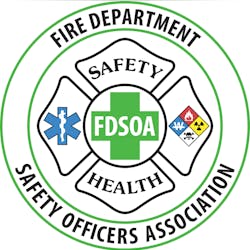FDSOA Symposium: Diesel Emissions Standards Need not be so Scary
SCOTTSDALE, Ariz. – Diesel emissions, regeneration and maintenance shouldn’t be as scary as some firefighters believe.
Ever since the federal Environmental Protection Agency (EPA) started cracking down on black soot spouting diesel engines about five years ago, firefighters flinch at new regulations and have been trying to push them back.
However, compliance rather than resistance is probably the better path to take.
So, said two presenters at the 28th annual Fire Department Safety Officers Association apparatus symposium in a presentation titled “Diesel Emissions Maintenance & Troubleshooting.”
The presenters were Wes Chestnut, Spartan Motors’ manager of product safety and compliance and Chris Crowel, the emergency vehicle market leader for Cummins.
Crowel told attendees to the presentation that diesel engine regeneration cycles are no different than self-cleaning ovens and should be no more scary than that.
“It’s really no different than that,” Crowel said. “It’s just like cleaning your oven.”
There are three types of regeneration, Crowel said, noting that the first kind happens automatically as the diesel engines simply run at high temperatures at high speed to burn all the soot. The second is active regeneration where a little fuel is put into the exhaust system to increase the temperature and the last is the manual, stationary regeneration.
“The manual regen is used when you can’t get out and up to highway speeds,” Crowel said. “That’s when we park the truck on the apron and let it run for 30 to 45 minutes to reduce the soot to ash.”
Crowel said much like a low level fuel light works on most vehicles, a dash light will illuminate to show that it’s time a regeneration process is needed.
“In the urban inner cities, that light might come on every three or four days,” Crowel said. “Then, you have to go through a manual regen.” He also said that since 2013, there are some apparatus that will increase idle speeds from about 800 rpm to 1,000 rpm in an effort to increase the heat to burn the soot.
While some firefighters would like to see fire apparatus exempt from the emissions standards, like the military, it won’t happen, Crowel said, adding it’s not likely that diesel emission fluid DEF will go away anytime soon either.
The fire service did get one concession, and that is a regeneration inhibit switch that allows firefighters to turn off the soot burning process to avoid starting fires in tall grass or where apparatus is operating near dry combustibles.
“We thought there were some conditions where a regen would not be advisable,” he said noting that it’s not a momentary switch. If left on too long, soot could build up and clog exhaust filtration systems.
Chestnut said firefighters need not fear loss of power, or de-rating, on fire apparatus while they are pumping.
“If it regenerates automatically when you’re pumping, it’s not going to affect it in any way,” Chestnut said. “You’re not going to lose anything.” That’s unlike normal trucks that can de-rate and lose power, cutting engine speeds to parade speeds.
Some of the attendees shared the equivalent of horror stories regarding their experiences with diesel emission components and maintenance issues. One participant said five gallons of DEF was dumped into the diesel tank on one of his department's apparatus causing all sorts of problems.
Crowel explained that DEF is comprised of urea and water, which makes it like salt water and diesel engines don’t run on water. He suggested that if the water separator on the apparatus didn’t catch all the moisture, the department might have to have the fuel tank removed and cleaned to make sure all the water is gone to avoid reoccurring problems. He said training would help solve that problem going forward.
Another participant said an OEM cab and chassis manufacturer was not being helpful with emissions problems and Crowel offered some advice on how to handle that situation, including checking with the engine manufacturer.
And still another complained about the cost the diesel emission reduction components cost, not only on the initial purchase, but for maintenance into the future.
And while the regulations are here to stay, said Chestnut, looking to the future, there doesn’t seem to be any killer requirements on the near horizon, certainly unlike some standards revisions that seemed, and were, onerous in the past.
“There will be some tightening up on the standards which are being driven by regulations,” Chestnut said of the next round of standards due in 2017. “But, as we know it today, nothing will change for the emergency vehicle segment. … The final rule is expected to come out later this year.”
More from FDSOA:
- FDSOA's Apparatus Symposium Opens in Ariz.
- FDSOA Symposium: Diesel Emissions Standards Need not be so Scary
- FDSOA Symposium: NFPA 2015 Apparatus Standards Reviewed
- FDSOA Symposium: Politics Play a Role in Apparatus Purchasing
- FDSOA Symposium: Experts Field Apparatus Questions
- FDSOA Symposium: Detroit FD Weathers City's Bankruptcy
- FDSOA Symposium: Apparatus Design Is Important for ISO Ratings
- FDSOA Symposium: Drones Can Be Valuable Tools For Responders
- FDSOA Symposium: NFPA Focused on Alternative Fuel Emergency Safety
- FDSOA Symposium: Graham Lectures on True Risk Managment
- FDSOA Symposium: Pros and Cons of Thermal Imagers Discussed
- FDSOA Symposium: Maintenance is Key to Keeping Apparatus on the Road
